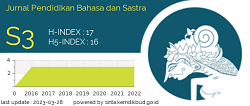The Utilization of Phonics Songs in Phonics Reading Classes in Indonesia: Teachers’ Perspectives
Abstract
The use of phonics approaches for teaching early reading skills to young learners in Indonesian EFL classes seems to be on the rise. However, as phonics relies on students’ ability in corresponding letters and the sounds of the letters, the fact that the English pronunciation for the alphabet is different from that of Bahasa Indonesia could be an obstacle in a way that it might lead students to confusion. To cope with this problem, some teachers are found to have applied phonics songs in order to help their young learners. This paper aims to report teachers’ perspectives on their experiences in utilizing phonics songs to help young learners in Indonesia develop their early reading skills. A case study is employed by using instruments of questionnaires and interviews involving 20 EFL teachers in Indonesia. The results show the teachers’ positive perspectives on the utilization of phonics songs in early reading classes as well as its benefits and drawbacks which can be aspects that teachers should seriously consider when choosing the most suitable phonics songs to be applied in young learners’ classes in Indonesia.
Keywords
Full Text:
PDFReferences
Ariati, N. P. P., Padmadewi, N. N., & Suarnajaya, I. W. (2018). Jolly phonics: effective strategy for enhancing children english literacy. In SHS Web of Conferences (Vol. 42, p. 00032). EDP Sciences.
Bald, J. (2007). Using phonics to teach reading and spelling. SAGE Publications.
Blevins, W. (2006). Phonics from a to z: A practical guide. Scholastic.
Brewster, J., Ellis, G., & Girard, D. (2002). The primary English teachers’ guide (2nd ed.). Penguin English.
Brown, H. D., & Lee, H. (2015). Teaching by principles: An interactive approach to language pedagogy (4th ed.). Pearson.
Campfield, D. E., & Murphy, V. A. (2017). The influence of prosodic input in the second language classroom: does it stimulate child acquisition of word order and function words?. The Language Learning Journal, 45(1), 81-99. https://doi.org/10.1080/09571736.2013.807864
Creswell, J. W., & Creswell, J. D. (2018). Research design: Qualitative, Quantitative, and Mixed Methods Approaches. (5th ed.). Sage.
Davis, G. M. (2017). Songs in the young learner classroom: A critical review of evidence. ELT Journal, 71(4), 445-455.
Hawkins, L. (2015). The effect of music on education and early literacy. Indiana State University. https://indstate.openrepository.com/handle/10484/12115.
Moreno, S., Friesen, D., & Bialystok, E. (2011). Effect of music training on promoting preliteracy skills: Preliminary causal evidence. Music perception, 29(2), 165-172.
Moroder, G. M. (2013). The effects of music and rhythm on phonics instruction with beginning readers. Master's Theses, Capstones, and Projects. 328.
https://digitalcommons.stritch.edu/etd/328
Musthafa, B. (2010) Teaching English to Young Learners in Indonesia: Essential Requirements. Educationist, 4(2), 120-125.
Nasution, A. K. R. (2019). YouTube as a media in English language teaching (ELT) context: Teaching procedure text. Utamax: Journal of Ultimate Research and Trends in Education, 1(1), 29-33.
Ngamkiatkhajorn, K., & Kanoksilapatham, B. (2018). Implementing Phonics in Elementary Education: An Effective Way to Gain Early English Literacy. International Journal of Learning and Teaching, 4(4), 345-349.
Paul, D. (2003). Teaching English to Children in Asia. Pearson Longman Asia ELT.
Rahmah, W., & Pandjaitan, L. N. (2018). The Effectivity of Phonics Method in Improving Reading Ability of 1st Grade Elementary School Students. Proceedings of Advances in Social Science, Education and Humanities Research, 173, 380-382.
Retnomurti, A. B., Hendrawaty, N., & Nurhayati, N. (2019). Strategi Pengenalan Membaca Phonics Method dalam Pengabdian kepada Masyarakat di Jakarta Selatan. JPP IPTEK (Jurnal Pengabdian dan Penerapan IPTEK), 3(1), 15-24. https://dx.doi.org/10.31284/j.jpp-iptek.2019.v3i1.473
Richards, J. C., & Rodgers, T. S. (2001). Approaches and methods in language teaching (2nd ed.). Cambridge University Press.
Scott, W. A., & Ytreberg, L. H. (1990). Teaching English to Children. Longman.
Sudiarta, I. W. (2017). Pengaruh metode jolly phonics terhadap kemampuan membaca dan menulis permulaan bahasa inggris pada anak kelompok B TK Mahardika Denpasar. Jurnal Imiah Pendidikan dan Pembelajaran, 1(3), 240-251.
Wahyuni, N. T., Fauziati, E., & Hikmah, M. (2016). The effectiveness of using phonics instruction and storybooks in English reading classes to improve student participation. Jurnal Penelitian Humaniora, 17(1), 49-64. https://doi.org/10.23917/humaniora.v17i1.2351
Yeni, M., & Amelia, R. (2020). Teaching Alphabet for Young Learners through Song. Journal of English Language Education, 5(2), 12-22.
DOI: https://doi.org/10.17509/bs_jpbsp.v22i2.55911
Refbacks
- There are currently no refbacks.
Copyright (c) 2023 Jurnal Pendidikan Bahasa dan Sastra
p-ISSN 1412-0712 | e-ISSN 2527-8312
JPBS is published by:
Fakultas Pendidikan Bahasa dan Sastra (Faculty of Language and Literature Education), Universitas Pendidikan Indonesia,
in cooperation with
TEFLIN, and APPBIPA


